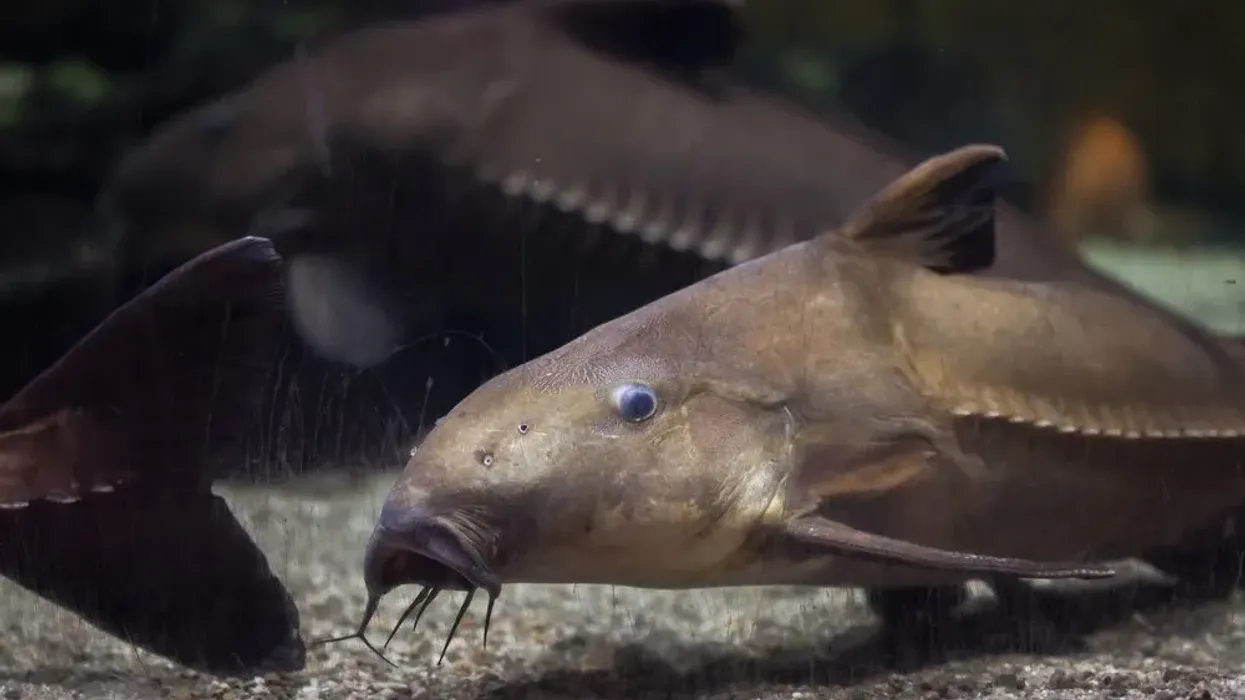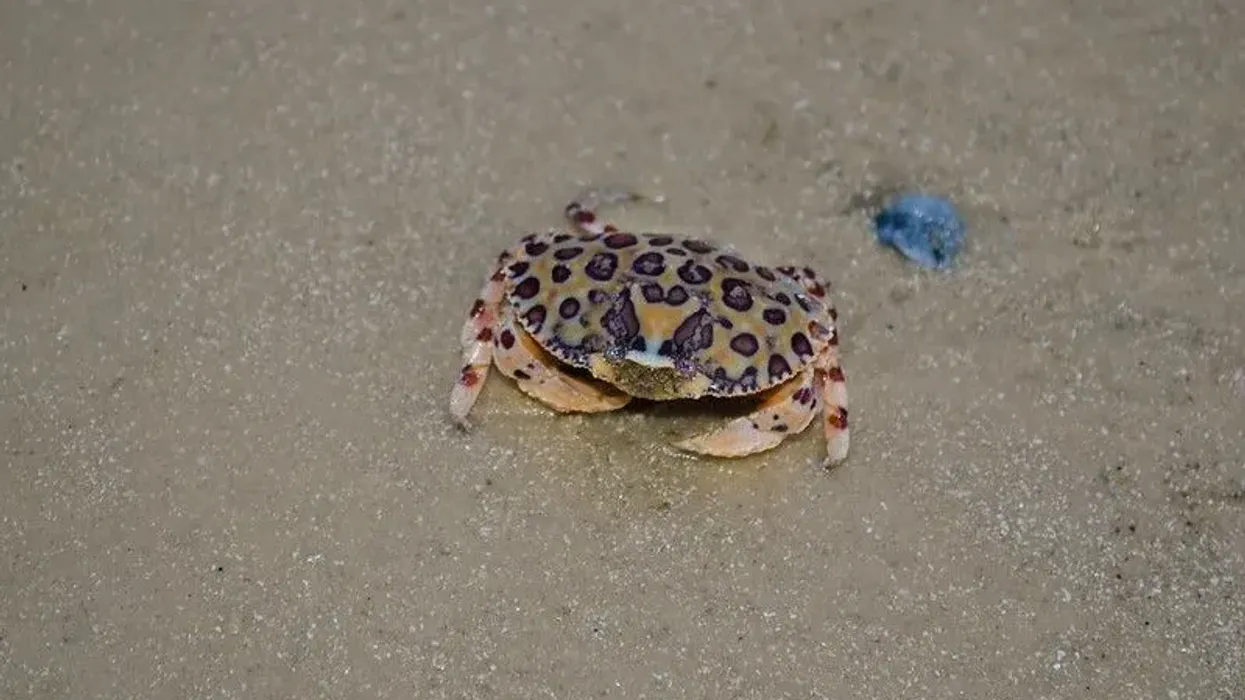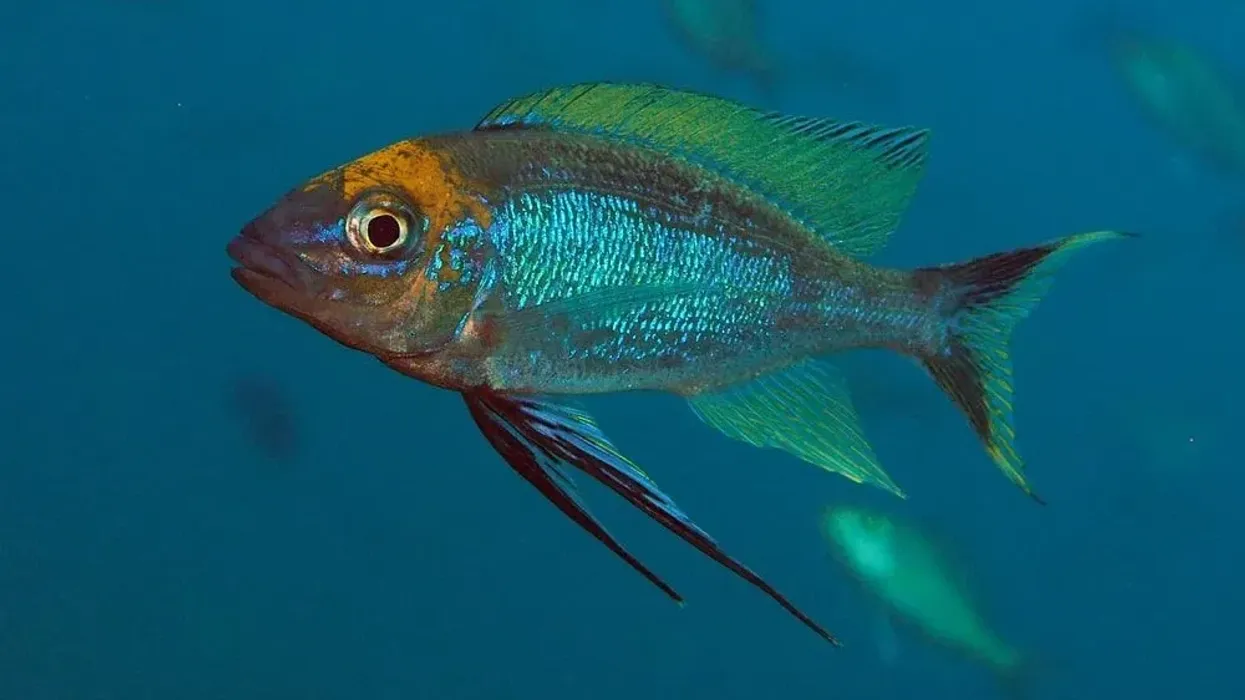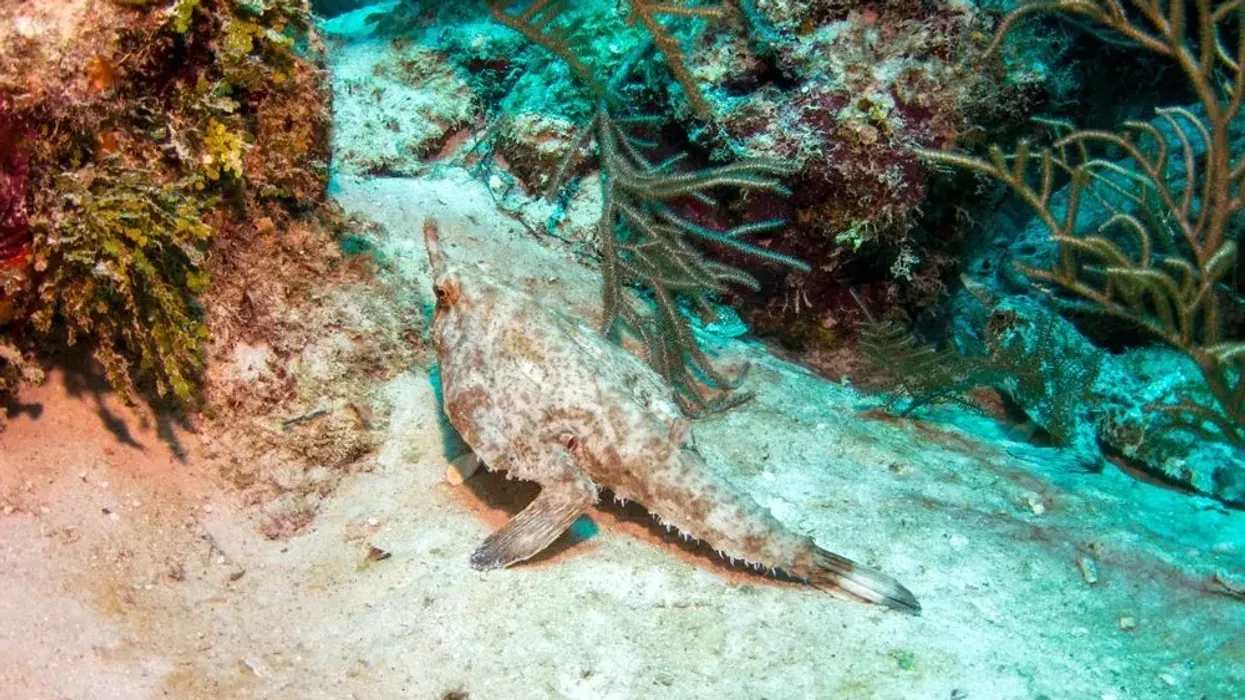The granulated catfish is a thorny catfish native to the Amazon and Paraná river basins. They are also found in the coastal drainages in Guyana and Suriname.
These fish species are sought after in the aquarium trade for public displays. In Greek, Pteron means wing or fin, and doras means skin. Their granulated skin explains why their scientific name is Pterodoras granulosus, known initially as Doras Granulosus Valenciennes.
These fish species are known by common names such as Armado, Bacu, Common Bacu, and Ru Tornmalle. They generally live in small groups and migrate during rainy seasons for spawning.
Did you know that granulated catfish, Pterodoras granulosus belong to the family Doradidae, also referred to as talking cats? They are called so as they make a peculiar stridulatory noise when removed from water due to their defense mechanism. Continue reading to learn more astonishing facts about this catfish.
If you like this article, check out chum salmon facts and yellowfin tuna facts as well!
Granulated Catfish Interesting Facts
What type of animal is a granulated catfish?
Granulated catfish is a thorny catfish species found in freshwater sources of South America.
What class of animal do a granulated catfish belong to?
Granulated catfish (Pterodoras granulosus) is a fish species that belongs to the class Actinopterygii and the genus Pterodoras. It is a thorny catfish species that generally possess high demand in commercial fishing.
How many granulated catfishes are there in the world?
The exact population of granulated catfish is currently unknown. However, the majority of this species are found in the continent of South America.
Where does a granulated catfish live?
The granulated catfish, Doras Granulosus, lives in freshwater sources of South America. They are found in the Amazon and Paraná rivers and Guyana and Suriname's coastal drainages. This fish species is also commercially caught for being displayed in a public aquarium. Due to its large size, the dorado needs a large tank to turn around comfortably.
What is a granulated catfish's habitat?
The South America Amazon basin and the Paraná basin serve as the natural habitat for this freshwater species. They are also native to Suriname and Guyana coastal drainage.
In addition, countries like Peru, Brazil, Paraguay, Uruguay, Argentina, Bolivia, and Ecuador find the presence of the fish in large numbers. The lagoons of the Amazon and Paraná rivers house the fish.
The catfish species live in the demersal zone, which means they live close to the river or lake bed. Freshwater sources with a pH range of 6.4-7.5 are suitable for Doras granulosus to thrive.
Who do granulated catfish live with?
Pterodoras granulosus is generally found in small groups. Being a migratory species, it migrates annually from large reservoirs and rivers to shallow flooded areas. Migration in small groups happens in the rainy season and primarily for spawning.
How long does a granulated catfish live?
The lifespan of the catfish Pterodoras granulosus is generally eight to 12 years. Unlike many other fish species, granulated catfish can stay alive for many hours after being drawn out of the water if their skin stays wet. As a result, we may sometimes find them alive in the markets.
How do they reproduce?
Catfish reproduce by spawning. Upon maturity, it can lay as many as 4000 to 100,000 eggs. However, more research is required to understand the nature of breeding and reproduction in granulated catfish.
They migrate in small groups during the rainy season for spawning. The ideal range of temperature of the water for spawning is between 68-75.2 F (20-24 C). Unfortunately, granulated catfish size doesn't make aquarium spawning feasible.
What is their conservation status?
As per the IUCN Red List, the conservation status of the granulated catfish is Not Evaluated. These native to South American fish species are of commercial importance as they are fished for consumption by people and public display in the aquarium.
Granulated Catfish Fun Facts
What do granulated catfish look like?

*Please note the image is of flathead catfish, a similar species, and not a granulated catfish. If you have an image of a granulated catfish, please reach out to us at hello@kidadl.com.
The granulated catfish is a thorny catfish species that can grow up to 28 in (70 cm) in length. The color of their body depends on two factors, their age, and their native location.
The juvenile species are generally muddy brown with several dark spots all over their body and fins. As they grow into adults, the dark spots fade away, and they get a uniform olive green tone.
A row of scutes or lateral plates found along the body is the characteristic feature of this species. They have a broad head with three pairs of barbels. They have tiny eyes compared to other species of fish.
One feature which distinguishes the granulated catfish from the other Doradids is its deeply forked caudal fin. The extended posterior fin or adipose fin forms a keel.
Another noteworthy feature of catfish is that they do not have scales. They have spines in front of the fins.
How cute are they?
Aquarium fish gazers find granulated catfish species exciting. They are attractive in the tank and are commercially fished and sold to be kept in public display in the aquaria. However, these gentle giants demand a bigger tank or a vast indoor pond to be kept.
How do they communicate?
In general, catfish communicate using sounds. They are capable of producing sounds in different velocities and pitches. In addition, their keen auditory reception helps distinguish between sounds of different nature and directions of origin. This mechanism helps them in social communication and during distress.
Granulated catfish belong to the family Doradidae that are also referred to as talking cats. They make a unique stridulatory noise when taken out of the water as a part of their defense mechanism.
However, very minimum information is available on the exact communication mechanism of the granulated catfish. Therefore, more studies are required to understand the way they communicate.
How big is a granulated catfish?
The granulated catfish is one of the larger catfish species. The adult granulated catfish can grow up to 28 in (70 cm) in length. Owing to their large size, they are required to be kept in a reasonably large tank in the aquaria.
Compared with the Asian stone catfish, which is one of the smallest in the catfish family, the granulated catfish are about 20 times larger in size. However, the granulated dorado is almost four times smaller when compared to Mekong giant catfish, which is the largest freshwater fish.
How fast can a granulated catfish swim?
The exact speed of granulated catfish is not available. But generally, catfish can swim up to a speed of 15 mph (24.1 kph). They keep moving about in search of food at the bottom of the water.
How much does a granulated catfish weigh?
An adult granulated catfish weighs up to 14 lb ( 6.5 kg ).
What are the male and female names of the species?
The male and the female species are known by the same common and scientific names. As far as the differences in sexuality, no significant external differences are reported. However, it is observed that female species are pretty well built and robust, while male species are slender.
What would you call a baby granulated catfish?
The baby of juvenile catfish is called a fry, which refers to the stage where the juvenile can feed for itself actively.
What do they eat?
Granulated catfish are omnivores that feed on a variety of food. They consume whatever is available, from mollusks to earthworms, prawns, and other aquatic creatures. They also feed on water, plants, and fruits.
It is observed that the granulated catfish feeds on non-native Bivalve and Corbicula fluminea and serves as a biological pest control. Did you know that granulated catfish helps in seed dispersal? Yes, it does. Studies show that seeds of the families Moraceae, Polygonaceae, and Gramineae were found in the fish's stomachs.
Granulated catfish, being nocturnal predators, hunt and feed during the nighttime.
Are they poisonous?
There is no evidence to show that the granulated catfish is poisonous. They are generally harmless and do not bite humans. They are commercially fished for display in the aquarium and for human consumption.
Would they make a good pet?
Granulated catfish are also meant to be aquarium displays. Apart from being caught for consumption by human beings, they are commercially sold for being displayed in public aquaria. Owing to their large size, they require a larger tank or a pond to be kept.
As aquarium species, they are pretty adaptive, like most other dorados. They require freshwater tanks with a pH value ranging from 6.4-7.5.
High pH can lead to skin and eye cloudiness. A tank temperature of 68-75.5 F (20-24 C) would be ideal for these dorados to thrive. These gentle giants would require a large indoor pond or a tank to house them.
They are peaceful tankmates and are compatible with other catfish species such as the Oscars, Megalodoras, and Leiarius. It is required to provide large pipes or hiding places for the catfish in the tank. Catfish benefit from having aquarium plants.
Heavily rooted plants help catfish to hide away from light. Plants such as bogwood, ferns can be placed in the tank.
Catfish are friendly tankmates. They do not get threatened or get preyed on. However, when they are not fed enough, they feed on other smaller fish.
Did you know...
Ever wondered why the catfish is called so? The granulated catfish have three pairs of barbels that resemble the whiskers of a cat. This distinctive feature is the reason behind the name - catfish.
Generally, fish have scales. However, one of the characteristic features of granulated catfish is that they do not have scales but have tough and thick skin. If their skin stays wet, they can survive even when taken out of water.
Do humans eat them?
Yes, granulated catfish is an edible species. Humans consume these catfish species. Thus, fishing of this species is of commercial importance. These species are widely found in South America- in the Amazon basin and the Paraná basin, and Suriname and Guyana coastal drainage. They are fished mainly for human consumption.
What do catfish eat in a tank?
In their natural habitat, catfish feed on mollusks, aquatic plants, and fruits. While in the tank, the catfish need to be fed to suit their requirements. Catfish are demersal and dwell in the bottom of the tank. Therefore, it is required to have many plants, gravel, and other stones in the bottom of the tank, to trap the food.
Generally, aquarium food includes pellets and store-bought catfish food like frozen bloodworms or shrimp. Catfish feed on whatever is available at the bottom of the aquarium. Sometimes, they stick to the glass to feed on algae that may be present. They also feed on snails found in the aquarium, thus getting rid of these pests.
Catfish are bottom feeders. They cannot consume food that stays afloat. They also need their food to be soft and mushy.
Here at Kidadl, we have carefully created lots of interesting family-friendly animal facts for everyone to discover! Learn more about some other fish from our herring facts and marlin facts pages.
You can even occupy yourself at home by drawing one on our free printable granulated catfish coloring pages.
*Please note that the main image is of a ripsaw catfish, a similar species and not a granulated catfish. If you have an image of the granulated catfish, please reach out to us at hello@kidadl.com.









